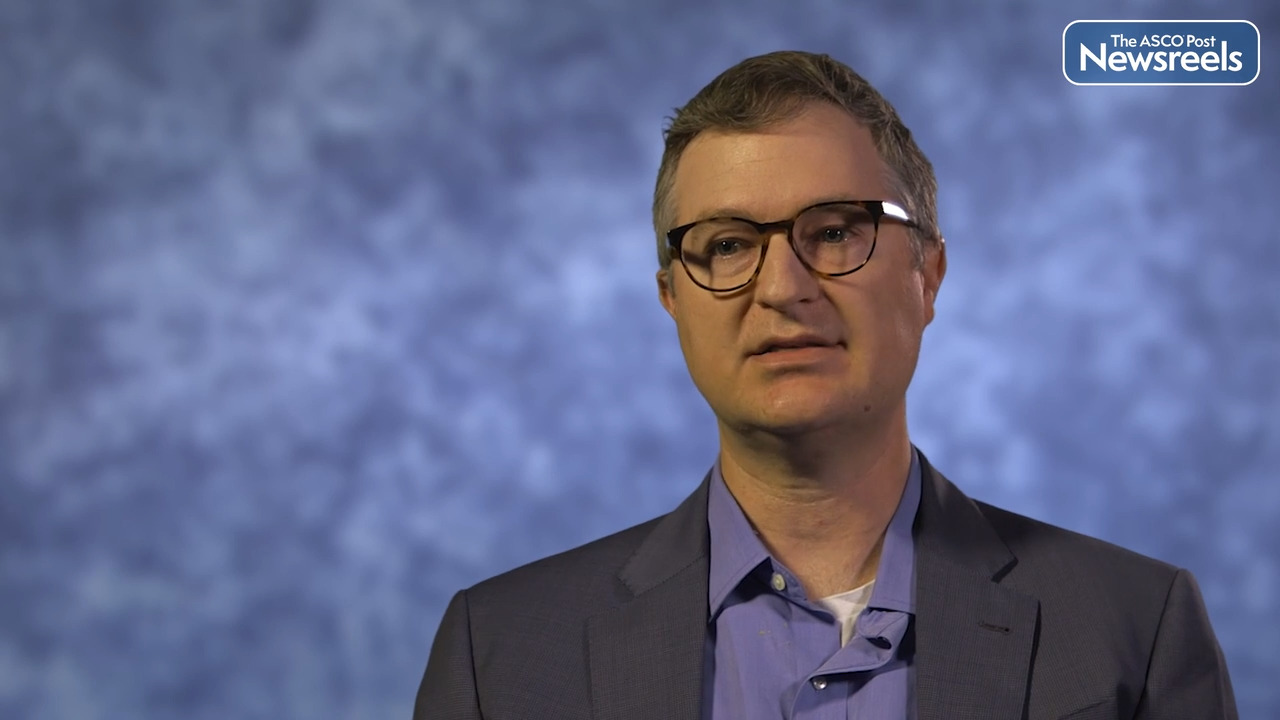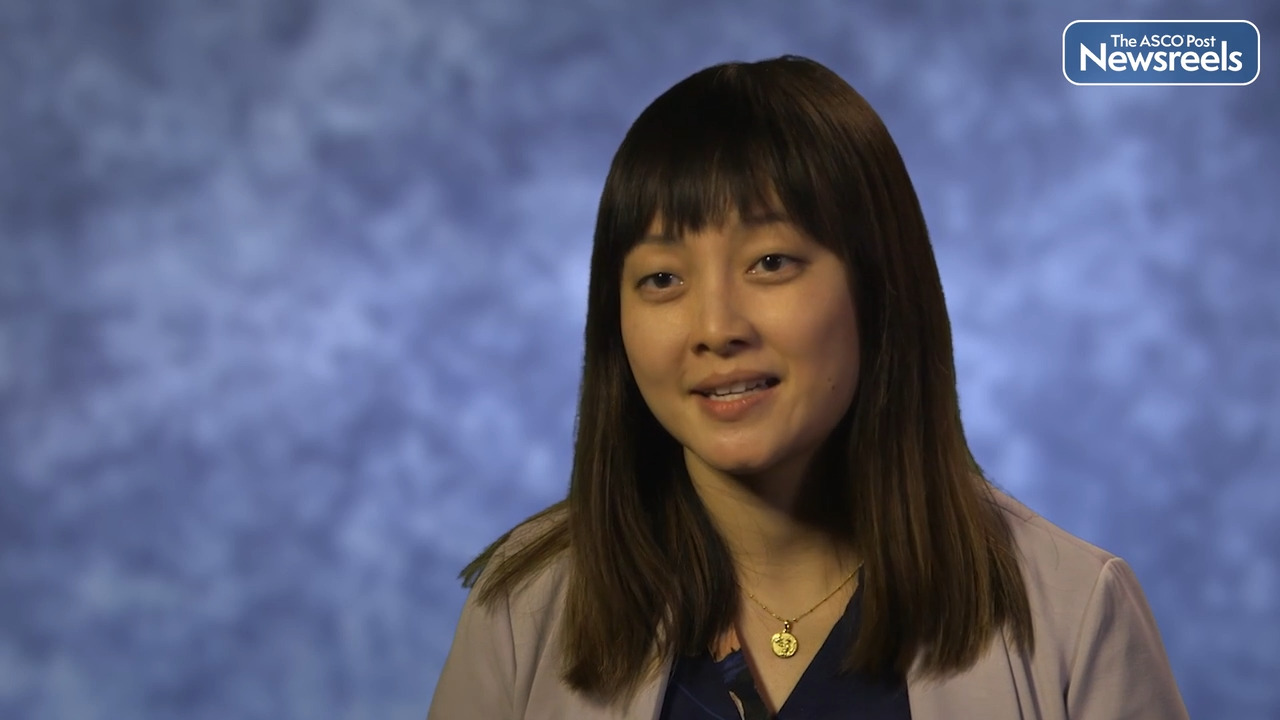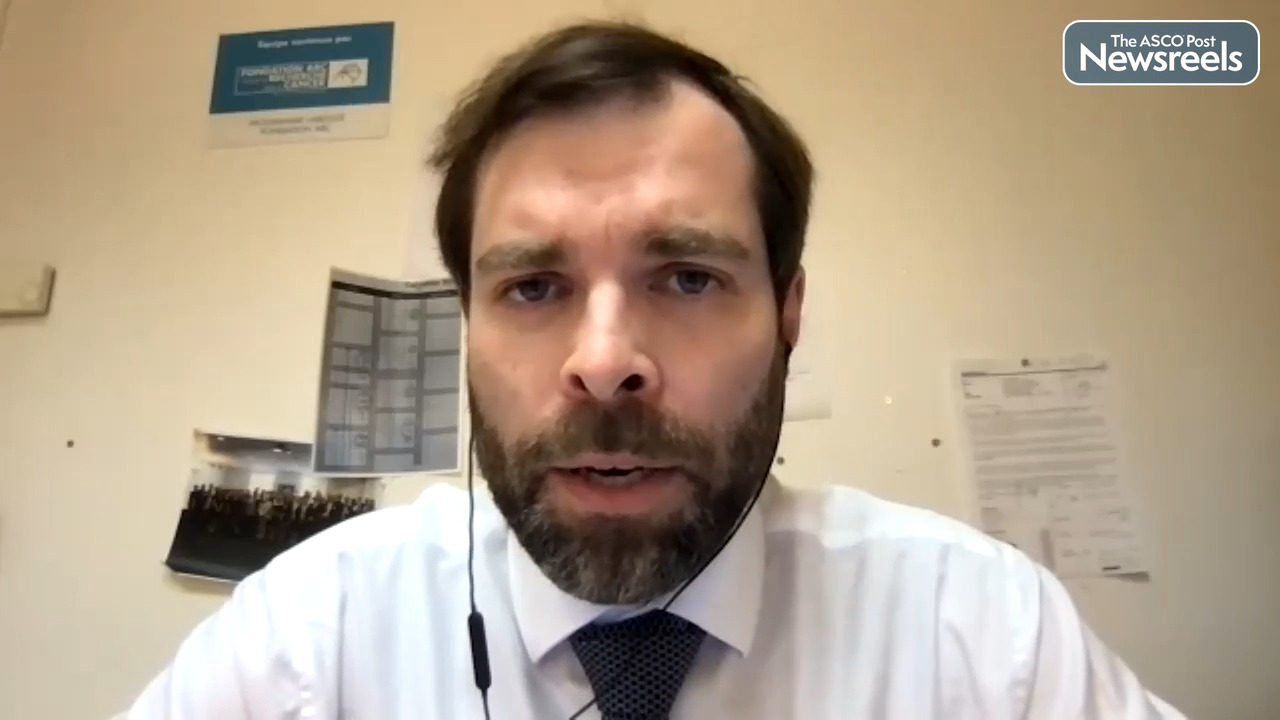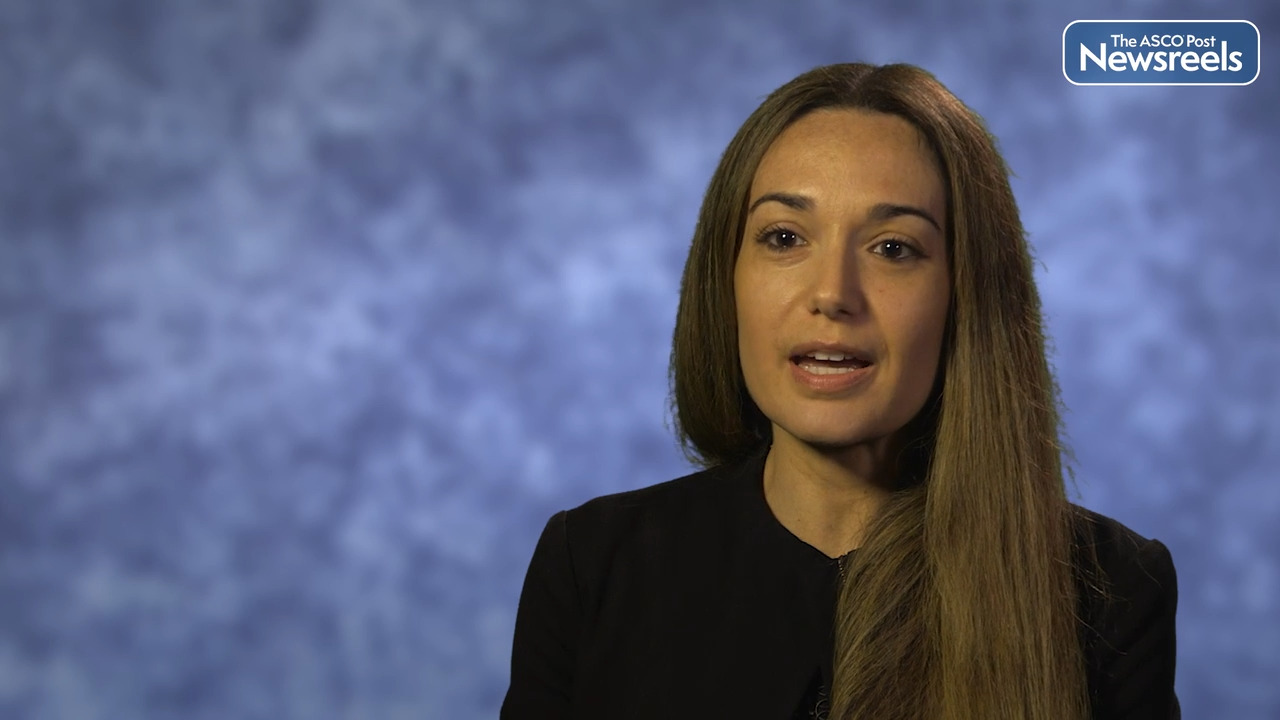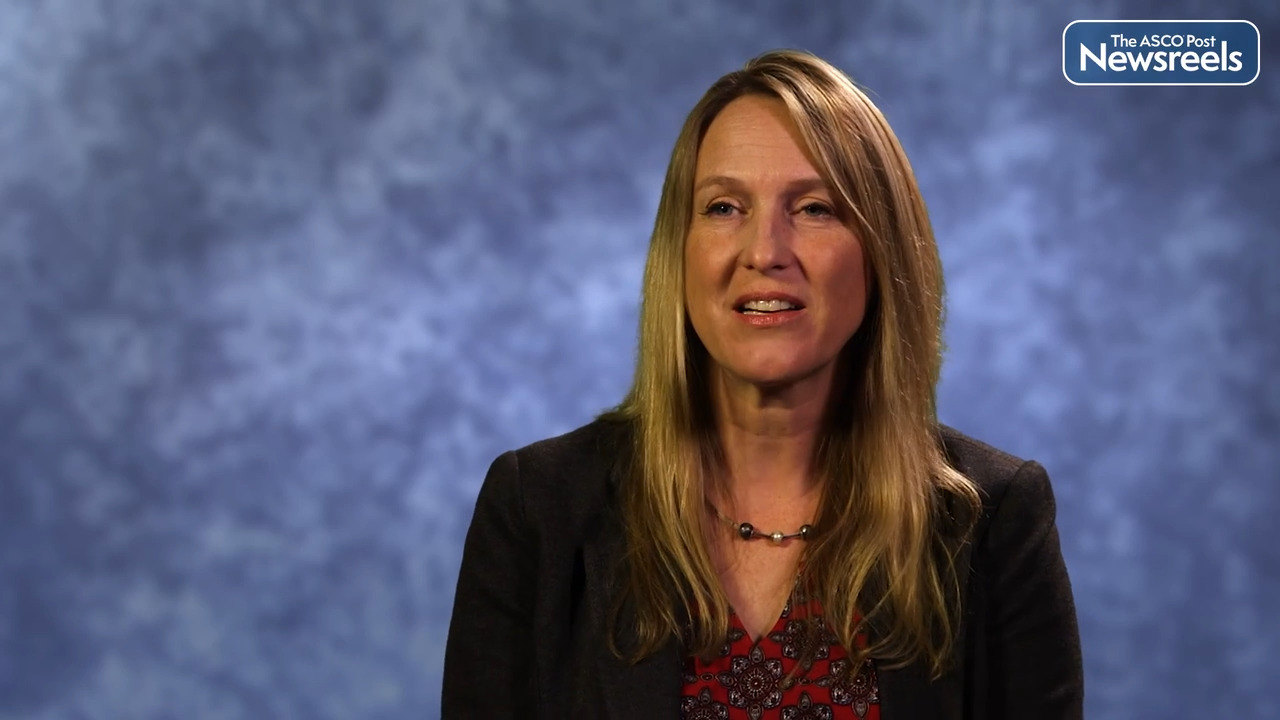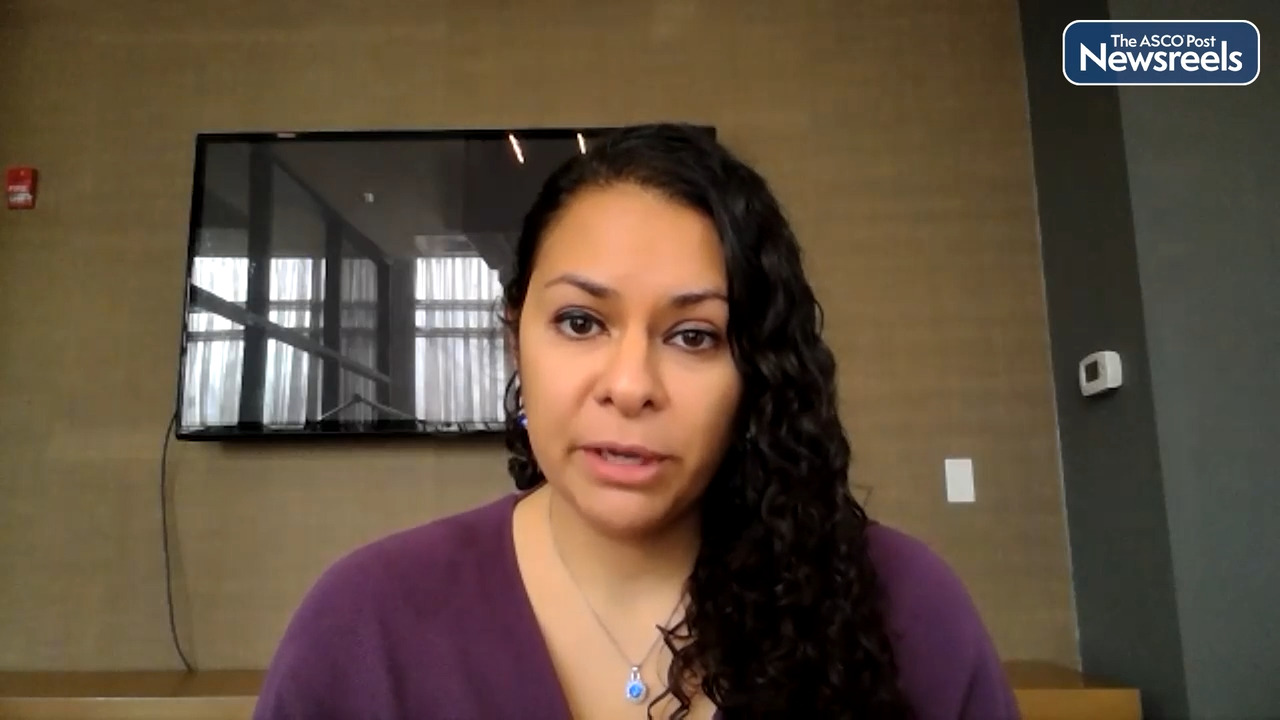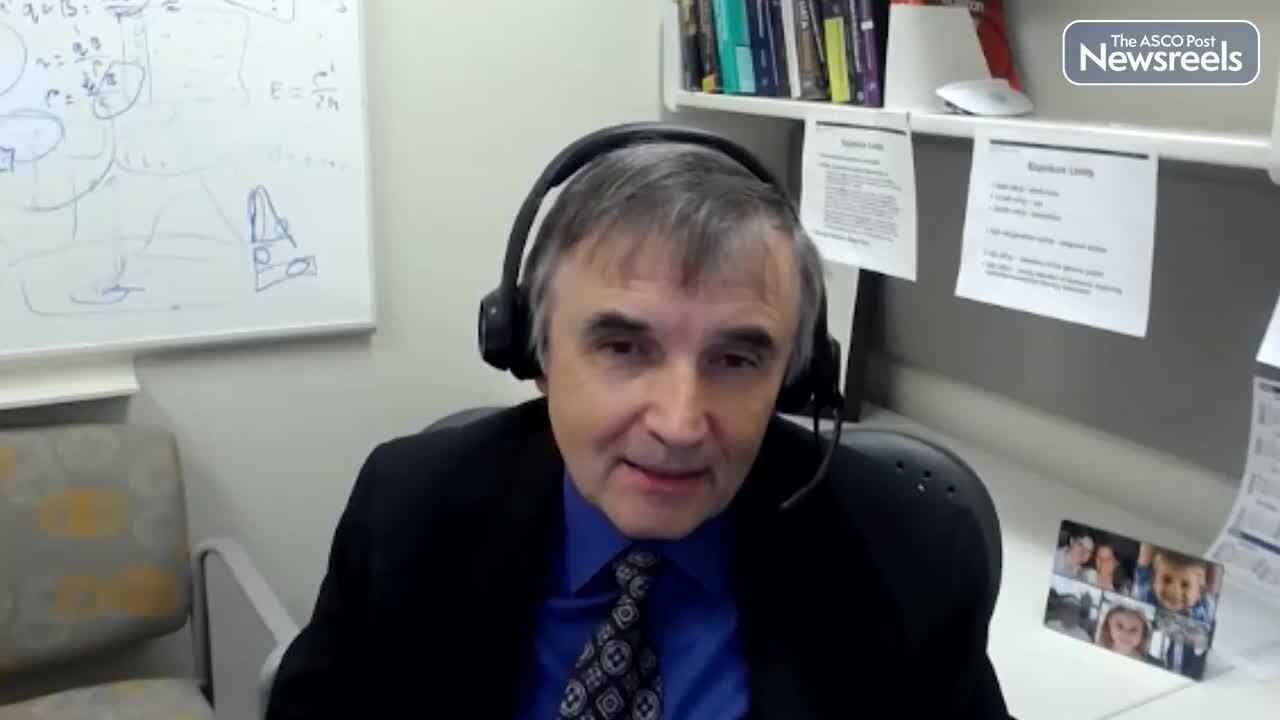Expert Point of View: Edward B. Garon, MD
Invited discussant of the NeoCOAST trial, Edward B. Garon, MD, Professor of Medicine and Director of the Thoracic Oncology Program at David Geffen School of Medicine at the University of California Los Angeles, praised the study: “NeoCOAST is an impressive study that showed numerical benefit when...
Novel Neoadjuvant Therapy May Boost Response in Resectable NSCLC
Use of multiple immune pathway inhibitors appears to be superior to checkpoint inhibitor therapy alone as neoadjuvant therapy for resectable non–small cell lung cancer (NSCLC), according to the results of the phase II NeoCOAST trial presented at the American Association for Cancer Research (AACR)...
Tazemetostat for Patients With Relapsed or Refractory BAP1-Inactivated Malignant Pleural Mesothelioma
In a phase II study reported in The Lancet Oncology, Zauderer et al found that the EZH2 inhibitor tazemetostat was active in patients with relapsed or refractory BRCA-associated protein 1 (BAP1)-inactivated malignant pleural mesothelioma. As noted by the investigators, high expression of EZH2 has...
Report Examines Imaging Approach With Potential to Detect Lung Cancer at the Cellular Level
Researchers have found a way to identify lung cancer at the cellular level in real time during a biopsy, which may enable detection of the disease earlier and with more confidence. The findings, published by Kennedy et al in Nature Communications, demonstrated that an imaging agent detected via...
Matthew L. Meyerson, MD, PhD, on Lung Adenocarcinoma: Somatic Mutations, Germline Risk, and Ancestry
Matthew L. Meyerson, MD, PhD, of the Dana-Farber Cancer Institute, discusses study findings that suggest the variation in frequency of EGFR and KRAS mutations in lung cancer may be associated with genetic ancestry in patients from Latin America. The results indicate it may be possible to identify germline alleles underpinning this link. Finding a germline locus or loci may impact the development of lung cancers with these mutations and may improve lung cancer prevention and screening for populations of Latin American origin, as well as others.
Patients With NSCLC Brain Metastases Undergoing Neurosurgical Resection: Comparison of Treatment Regimens
In a German single-institution retrospective cohort study reported in JAMA Network Open, Wasilewski et al found that treatment with immune checkpoint inhibition plus radiotherapy was associated with prolonged overall survival vs platinum-based chemotherapy plus radiotherapy in patients with brain...
Ara Klijian, MD, on Lung Cancer: Operability in Patients With Poor Pulmonary Function
Ara Klijian, MD, of Scripps Health, discusses findings on the safety of AVATS (awake video-assisted thoracic surgery), a procedure that may benefit select patients, including those whose early non–small cell lung cancer was previously deemed inoperable due to poor pulmonary function. Performed under local sedation, AVATS appeared to improve outcomes, reduce hospital stays, increase patient satisfaction, and lower costs.
Beyond Immunotherapy: New Targeted Agents for Advanced NSCLC
The advent of PD-1 and PD-L1 checkpoint inhibitors has changed the treatment landscape of advanced non–small cell lung cancer (NSCLC), but only approximately 20% of patients treated with immunotherapy will be alive at 5 years. According to Melissa L. Johnson, MD, Director, Lung Cancer Research,...
DESTINY-Lung01: Is Trastuzumab Deruxtecan the Answer for HER2-Mutant Lung Cancer?
The human epidermal growth factor (HER) family of receptors are a well-established therapeutic target. Indeed, seminal studies conducted nearly 2 decades ago identified a key association between activating mutations in the kinase domain of the epidermal growth factor receptor (EGFR, also known as...
DESTINY-Lung01: T-DXd Shows Durable Activity in Previously Treated Metastatic HER2-Mutant NSCLC
In a phase II trial (DESTINY-Lung01) reported in The New England Journal of Medicine, Bob T. Li, MD, PhD, MPH, of the Thoracic Oncology and Early Drug Development Service, Memorial Sloan Kettering Cancer Center, New York, and colleagues found that fam-trastuzumab deruxtecan-nxki (T-DXd) showed...
Neoadjuvant Nivolumab and Platinum-Doublet Chemotherapy for Early NSCLC
On March 4, 2022, nivolumab was approved for use with platinum-doublet chemotherapy for resectable non–small cell lung cancer (NSCLC) in the neoadjuvant setting.1 The approval is the first for neoadjuvant therapy for early-stage NSCLC. Supporting Efficacy Data Approval was based on findings from...
2-Year Follow-up Shows Durable Responses With Sotorasib in KRAS G12C–Mutated Non–Small Cell Lung Cancer
Sotorasib, the first KRAS G12C inhibitor approved for the treatment of KRAS G12C–mutated non–small cell lung cancer (NSCLC), continues to demonstrate meaningful and durable efficacy at 2-year follow-up in the phase II CodeBreaK 100 trial. At a median follow-up of 24.9 months, the 2-year overall...
Consolidation Durvalumab Alone or Combined With Oleclumab or Monalizumab for Unresectable Stage III NSCLC
In an interim analysis of the phase II COAST trial reported in the Journal of Clinical Oncology, Roy S. Herbst, MD, PhD, FACP, FASCO, and colleagues found that consolidation durvalumab in combination with the anti-CD73 antibody oleclumab or anti-NKG2A antibody monalizumab both improved objective...
Segmentectomy vs Lobectomy in Small-Sized Peripheral NSCLC
In a Japanese phase III trial (JCOG0802/WJOG4607L) reported in The Lancet, Saji et al found that segmentectomy was both noninferior and superior to lobectomy as measured by overall survival in patients with small-sized peripheral non–small cell lung cancer (NSCLC). Study Details In the open-label...
Study Examines Link Between Emphysema and Lung Cancer Risk
Computed tomography (CT)-detected emphysema may be linked to a higher risk of lung cancer, a risk that increases with emphysema severity, according to a new study published by Yang et al in the journal Radiology. Lung cancer is the primary cause of cancer-related death worldwide. However, lung...
Incidental Findings on Low-Dose CT Lung Cancer Screening in the NLST and Risk of Respiratory Disease Mortality
In an analysis of data from the National Lung Screening Trial (NLST) reported in Chest, Paul F. Pinsky, PhD, of the Division of Cancer Prevention, National Cancer Institute, and colleagues found that incidental respiratory disease–related findings on low-dose computed tomography (CT) screening...
Study Reports Adjuvant Pembrolizumab Improves Disease-Free Survival in Early-Stage NSCLC
Adjuvant pembrolizumab improves disease-free survival compared with placebo in patients with early-stage non–small cell lung cancer (NSCLC) following complete resection and adjuvant chemotherapy when indicated. These findings from the PEARLS/KEYNOTE-091 trial were reported in a European Society for ...
CHOICE-01: Toripalimab Plus Chemotherapy Improves Survival in Advanced NSCLC Without Actionable Mutations
Adding the PD-1 inhibitor toripalimab to chemotherapy significantly improved survival compared with chemotherapy alone in patients with advanced non–small cell lung cancer (NSCLC) without EGFR/ALK mutations, according to research presented during the 2022 ASCO Monthly Plenary Series.1 At the...
CheckMate 816: Neoadjuvant Nivolumab Plus Chemotherapy in Resectable NSCLC
As reported in The New England Journal of Medicine by Forde et al, the phase III CheckMate 816 trial has shown improved pathologic complete response rate and event-free survival with the addition of nivolumab to platinum-based chemotherapy in the neoadjuvant treatment of resectable non–small cell...
David A. Barbie, MD, on Mesothelioma: Activating the STING Pathway May Promote Antitumor Immunity
David A. Barbie, MD, of Dana-Farber Cancer Institute, discusses his laboratory’s studies, showing that malignant pleural mesothelioma, an inflamed cancer type with marginal response to immune checkpoint blockade, demonstrated high tumor cell STING expression and response to STING agonists in combination with natural killer cell therapies ex vivo. STING is the tumor cell stimulator of interferon genes (Abstract 4168).
Jia Luo, MD, on NSCLC: Clinicopathologic and Molecular Characterization of KRAS G12D–Mutated Disease
Jia Luo, MD, of Dana-Farber Cancer Institute, discusses the emerging class of cancer therapies for allele-specific KRAS inhibitors and the importance of their distinct clinical, genomic, and immunologic features. Because KRAS G12D–mutated non–small cell lung cancer is associated with worse responses to immunotherapy, Dr. Luo believes drug development will need to take these differences into account (Abstract 4117).
Nicolas Girard, MD, PhD, on NSCLC: New Data on Event-Free Survival With Nivolumab Plus Platinum-Doublet Chemotherapy
Nicolas Girard, MD, PhD, of the Institut Curie, discusses findings from the phase III CheckMate 816 trial, which is the first study with an immunotherapy-based combination to demonstrate improved event-free survival and pathologic complete response in the neoadjuvant setting for patients with resectable stage IB to IIIA non–small cell lung cancer. The results may benefit the 30% to 55% of patients whose cancer recurs after surgery (Abstract CT012).
In the Neoadjuvant Setting, Combination Immunotherapy With Durvalumab Is More Effective Than Durvalumab Alone for Early-Stage NSCLC
Combination immunotherapy with the anti–PD-L1 monoclonal antibody durvalumab and other novel agents outperforms durvalumab alone in the neoadjuvant setting for early-stage non–small cell lung cancer (NSCLC), according to research presented by Cascone et al at the American Association for Cancer...
Tina Cascone, MD, PhD, on NSCLC: New Findings From the NeoCOAST Trial on Durvalumab-Based Therapy
Tina Cascone, MD, PhD, of The University of Texas MD Anderson Cancer Center, discusses the findings of the phase II NeoCOAST study, which showed that combination immunotherapy with the anti–PD-L1 monoclonal antibody durvalumab and other novel agents resulted in numerically higher major pathologic response rates than durvalumab alone in the neoadjuvant setting for patients with early-stage resectable non–small cell lung cancer. Translational results also supported combination therapies over single-agent therapy (Abstract CT011).
Sotorasib Achieves Durable Responses in KRAS G12C–Mutated Lung Cancer
Sotorasib, the first KRAS G12C inhibitor approved for the treatment of KRAS G12C–mutated non–small cell lung cancer (NSCLC), continues to demonstrate meaningful and durable efficacy at 2-year follow-up in the phase II CodeBreaK 100 trial. At a median follow-up of 15.3 months, 2-year overall...
Patients With Lung Cancer and a Genetic Variant Linked to Autoimmune Disease May Be Especially Responsive to Immunotherapy
A variant of the CTLA-4 gene associated with autoimmune disease was found to be more frequent in patients with non–small cell lung cancer (NSCLC) who experienced an exceptionally high response to anti–PD-1 immunotherapy and a higher rate of immune-related side effects than in a comparable cohort of ...
Alana L. Welm, PhD, on Metastatic Outgrowth in the Lungs: Identifying a New Immune-Mediated Pathway
Alana L. Welm, PhD, of the University of Utah Huntsman Cancer Institute, discusses her findings of a new pathway that regulates the antitumor immune response during metastatic outgrowth. Interfering with a particular isoform of RON kinase may cause metastatic tumors to be swarmed by T cells and killed, suggesting that new approaches to targeting this kinase may be achievable in the near future (Abstract SY32).
Rapid Guideline Revises Recommendations for Adjuvant Therapy in Patients With Early-Stage Lung Cancer
A rapid recommendation update to an ASCO guideline offers revised parameters for adjuvant therapy in patients with resected non–small cell lung cancer (NSCLC) who have stage IB to IIIA disease.1,2 The new guidance reflects the findings from two randomized clinical trials that assessed the use of...
Anetumab Ravtansine vs Vinorelbine in Relapsed Mesothelin-Positive Advanced Malignant Pleural Mesothelioma
In the phase II ARCS-M trial reported in The Lancet Oncology, Hedy L. Kindler, MD, FASCO, and colleagues found that the antimesothelin antibody–tubulin inhibitor conjugate anetumab ravtansine did not improve progression-free survival vs vinorelbine as second-line treatment for patients with...
Collaboration Finds International Disparities in Screening, Treatment, and Outcomes for Patients With Lung Cancer
A consensus reached by a lung cancer clinical community within the International Cancer Benchmarking Partnership (ICBP) presented by Lynch et al at the European Lung Cancer Congress (Abstract 196P) has highlighted international disparities in the management and outcomes of patients with lung cancer ...
Registry Study Shows a Real-World Increase in Biomarker Testing Among Patients With Advanced NSCLC
More than half of patients diagnosed with advanced non–small cell lung cancer (NSCLC) undergo biomarker testing, and this figure has increased over the past 5 years, according to real-world data from a Spanish national registry study reported by Calvo de Juan et al at the European Lung Cancer...
Guideline-Concordant Surgery and Adjuvant Chemotherapy for Early-Stage NSCLC
In a retrospective cohort study reported in JAMA Oncology, Kenneth L. Kehl, MD, MPH, and colleagues found that only a slight majority of patients with early-stage non–small cell lung cancer (NSCLC) who were enrolled in a U.S. screening study (ALCHEMIST) received guideline-recommended adequate lymph ...
Adjuvant Pembrolizumab May Improve Disease-Free Survival in Patients With Early-Stage NSCLC
Adjuvant pembrolizumab may improve disease-free survival compared to placebo in patients with early-stage non–small cell lung cancer (NSCLC) following complete resection and adjuvant chemotherapy when indicated, investigators from the PEARLS/KEYNOTE-091 trial reported in a European Society for...
Lung Cancer Diagnosis With Low-Dose CT Screening and a Program for Management of Incidentally Detected Lung Nodules
In the prospective observational DELUGE study reported in the Journal of Clinical Oncology, researchers in the Baptist Memorial Health Care Corporation (BMHCC) found that programs for low-dose computed tomography (CT) screening and for management of incidentally detected lung nodules were...
Front-Line Toripalimab Plus Chemotherapy Improves Survival in Patients With Advanced NSCLC Without Actionable Mutations
Adding the PD-1 inhibitor toripalimab to chemotherapy significantly improved survival compared with chemotherapy alone in patients with advanced non–small cell lung cancer (NSCLC) without EGFR/ALK mutations, according to research presented by Wang et al during the March 2022 session of the ASCO...
Intervention for Racial Disparities in Time to Lung Cancer Surgery: ACCURE Trial
In an analysis from the Accountability for Cancer Care through Undoing Racism and Equity (ACCURE) trial reported in the Journal of Clinical Oncology, Marjory Charlot, MD, MPH, MSc, and colleagues found that the ACCURE intervention reduced the disparity between Black and White patients in time to...
FDA Approves Neoadjuvant Nivolumab and Platinum Doublet Chemotherapy for Early-Stage NSCLC
On March 4, the U.S. Food and Drug Administration (FDA) approved nivolumab (Opdivo) in combination with platinum-doublet chemotherapy for adult patients with resectable non–small cell lung cancer (NSCLC) in the neoadjuvant setting. This represents the first FDA approval for neoadjuvant therapy for...
Esophagus-Sparing vs Standard Palliative Radiation for Patients With Advanced Central NSCLC
As reported in JAMA Oncology by Louie et al, the Canadian phase III PROACTIVE trial showed that esophagus-sparing intensity-modulated radiotherapy (ES-IMRT) did not significantly improve esophageal quality of life vs standard radiotherapy in patients with advanced central non–small cell lung cancer ...
Do Diagnostic Delays Impact Overall Survival in Patients With NSCLC?
In a Surveillance, Epidemiology, and End Results (SEER)-Medicare Database analysis reported in JCO Oncology Practice, Romine et al found that longer time from suspicion to histologic diagnosis of non–small cell lung cancer (NSCLC) was associated with better overall survival; however, this effect...
Abemaciclib for Previously Treated Patients With p16ink4A-Deficient Mesothelioma
As reported in The Lancet Oncology by Dean A. Fennell, FRCP, and colleagues, a phase II trial (MiST2) showed the activity of abemaciclib in previously treated patients with p16ink4A-deficient malignant mesothelioma. As stated by the investigators, “Genetically stratified therapy for malignant...
Incidental Findings on Low-Dose CT Lung Cancer Screening in the NLST and Risk of Respiratory Disease Mortality
In an analysis of data from the National Lung Screening Trial (NLST) reported in Chest, Pinsky et al found that incidental respiratory disease–related findings on low-dose computed tomography (CT) screening were common and associated with an increased risk of mortality from respiratory diseases....
Updated Efficacy and Safety Data From CheckMate 743: First-Line Nivolumab/Ipilimumab vs Chemotherapy for Unresectable Malignant Pleural Mesothelioma
With a follow-up of at least 3 years, the results from the CheckMate 743 study represent the first long-term survival data in a phase III study evaluating first-line immune checkpoint inhibition in patients with unresectable malignant pleural mesothelioma. Overall, 23% of patients treated with...
Importing Oncology Trials From China, or Other Single Foreign Countries, for Consideration of U.S. Regulatory Approvals
In a commentary published in The Lancet Oncology, Harpreet Singh, MD, and Richard Pazdur, MD, both of the Oncology Center of Excellence at the U.S. Food and Drug Administration (FDA), warned against the increasing number of oncology drug development programs based wholly or predominantly on data...
Study Finds Patients With Lung Cancer Demonstrated Psychological Resilience in the Face of the COVID-19 Pandemic
Far from being hobbled by fears of COVID-19, patients with lung cancer actually showed less depression and anxiety during the pandemic than their healthy peers, according to results from a new study by Arrato et al published in JNCCN–Journal of the National Comprehensive Cancer Network. Researchers ...
CMS Expands Coverage of Lung Cancer Screening With Low-Dose CT
On February 10, the Centers for Medicare & Medicaid Services (CMS) announced a national coverage determination that expands coverage for lung cancer screening with low-dose computed tomography (CT) to improve health outcomes for people with lung cancer. This type of screening is aimed at early...
Use of Consolidation Durvalumab and Adjuvant Osimertinib Among Key Recommendations in New ASCO Guideline on Stage III NSCLC Treatment
A new ASCO guideline provides key recommendations for the evaluation and management of stage III non–small cell lung cancer (NSCLC). Recommendations made by the ASCO expert panel cover evaluation and staging of NSCLC, neoadjuvant and adjuvant therapies, and the management of unresectable ...
Narjust Duma, MD, on Advanced NSCLC: Reducing Racial Disparities in Outcomes
Narjust Duma, MD, of Dana-Farber Cancer Institute, discusses the many factors that lead to poorer outcomes in lower-income and minority patients with advanced non–small cell lung cancer and the urgent need to address these disparities and physician bias. Women of color and other minority patients are less likely to be offered lung cancer screening; participation in clinical trials; referral to palliative and hospice care services; or genome sequencing of their tumors.
Mirek Fatyga, PhD, on NSCLC: New Data on Stereotactic Body Radiotherapy vs Conventionally Fractionated Radiotherapy
Mirek Fatyga, PhD, of Mayo Clinic Arizona, discusses his findings on overall survival in patients with locally advanced non–small cell lung cancer who are treated with stereotactic body radiotherapy or conventionally fractionated radiotherapy. He notes that a high dose of > 50 Gy to the right-superior portion of the heart likely affects its conduction system. A low dose of < 5 Gy to the inferior segments of the heart may also cause heart damage and toxicity through blood irradiation.
Sugemalimab After Concurrent or Sequential Chemoradiation for Unresectable Stage III NSCLC
In an interim analysis of the Chinese phase III GEMSTONE-301 study reported in The Lancet Oncology, Zhou et al found that the PD-L1 inhibitor sugemalimab prolonged progression-free survival vs placebo in patients with locally advanced unresectable stage III non–small cell lung cancer (NSCLC)...
PACIFIC Trial: 5-Year Survival Outcomes With Durvalumab After Chemoradiotherapy in Stage III NSCLC
As reported in the Journal of Clinical Oncology by Spigel et al, long-term follow-up of the phase III PACIFIC trial has shown maintained progression-free and overall survival benefits with consolidation durvalumab vs placebo after chemoradiotherapy in unresectable stage III non–small cell lung...


